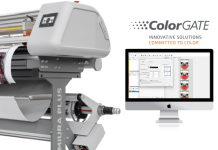According to Bradley Cooper, writing for Digital Signage Today, some companies are starting to move towards touchless interactive experiences allowing customers to simply speak to a display for whatever task they want to accomplish. Other companies, however, are finding ways to help keep touchscreens clean.
As the world continues to tackle the Covid-19 pandemic, customers are starting to change their habits, especially when it comes to germs and touching surfaces. This presents a key problem for touchscreen end users, since customers obviously have to touch a screen directly with their finger and at times gloved hands might not work as accurately on the screen.
Digital Signage Today spoke with Debbie DeWitt, marketing communications manager at Visix Inc. to get her take on whether touchscreens are still worth it, how end users can help keep them clean and whether touchless experiences will start to take off.
Q. Are customers leaning more towards interactive solutions? Why or why not?
The interactive signage market has grown every year for over a decade, and we don’t expect that to stop. People today expect to interact with any screen they encounter, so most retail spaces offer touchscreens, and we’re also seeing them in more and more corporate, education and government spaces.
Since people walk around with a touchscreen in their pocket, they expect other screens to behave the same way. Interactivity improves the customer experience by meeting those expectations, and the venue can pack a lot more info into a single touchscreen, which means more engagement at a lower cost, so it’s a win-win.
Q. What are some customer concerns with interactivity during Covid-19?
Obviously, there’s a lot of concern about germ transmission on surfaces like touchscreens. That’s especially true for hospitals and other healthcare facilities. On the other hand, by offering touchscreens, you can reduce the amount of face-to-face contact between staff and visitors asking for basic information. It’s a balancing act that requires some basic precautions – see next question.
Q. How can end users ensure their touchscreens stay clean?
Venues can place hand sanitiser and screen wipes at interactive kiosks with reminders for people to use them both before and after touching the screen. Also, while distancing recommendations are still in place, you can encourage people not to crowd around touchscreens by putting some markers on the floor to help guide queue spacing.
Q. Do you think this pandemic will boost the demand for touchless interactive experiences?
Yes. Voice user interfaces are becoming ubiquitous at home with virtual assistants like Alexa, Siri and Google Assistant, so it makes sense that users will want the same option in public forums.
Unfortunately, we may not see the end of Covid-19 for several years, and experts are predicting that similar viruses are likely to bloom in the future. It makes sense for both venues and users to move away from touching surfaces over the next few years.
Q. What measures should businesses take with their interactive digital signage to ensure a safe but effective customer experience?
A. Businesses can take some pretty simple steps to quell customer concerns by keeping sanitation products in place near touchscreens. They should also plan to build reminders into the on-screen content, with prompts users to use hand sanitiser, wipe screens and wash hands after use. Or, they can scrap the touch option altogether and move to a voice interface. The beauty is, you can use one, the other, or both simultaneously. Since it’s all about the customer experience — why not give them multiple safe choices?
To submit your news please, contact journo@practicalpublishing.co.za
Submit your news and video content to journo@practicalpublishing.co.za
Subscribe to our YouTube channel, read the top 5 stories weekly on WhatsApp or sign up to our newsletter.
This article appears in Digital Signage Today.















